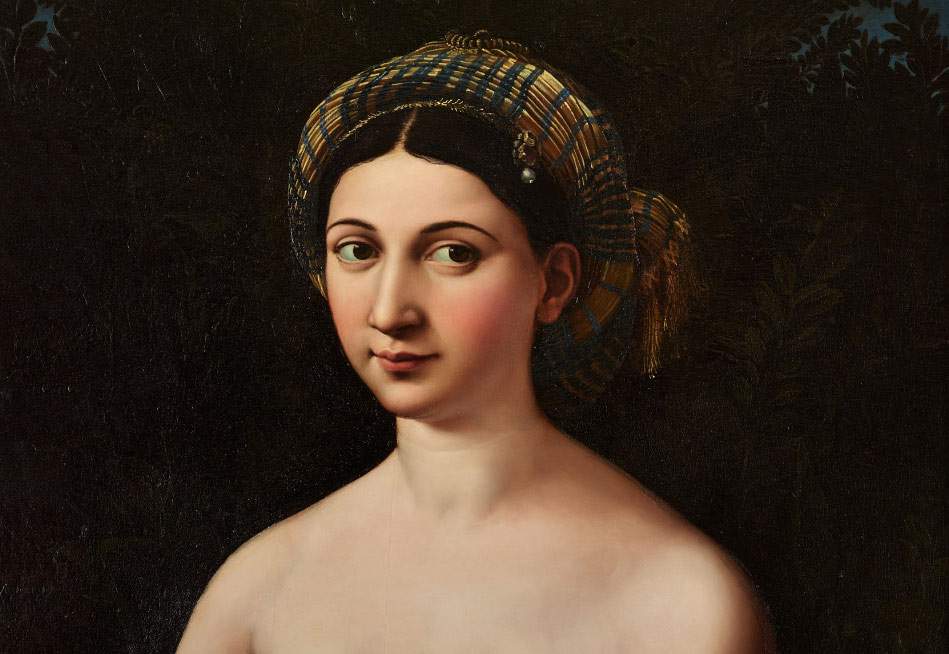New investigation into the Fornarina unveils full complexity of Raphael's masterpiece
The results of the investigation campaign to which the Fornarina, the masterpiece by Raphael Sanzio (Urbino, 1483 - Rome, 1520) preserved at the National Gallery of Palazzo Barberini in Rome, was subjected were presented today. The presentation meeting was attended by Paolo Branchini (INFN-National Institute of Nuclear Physics Section of Roma Tre), Alessandro Cosma (Barberini Corsini National Galleries), Giovanna Martellotti (CBC Conservazione Beni Culturali Soc. Coop), Chiara Merucci (Barberini Corsini National Galleries) and Claudio Seccaroni (ENEA). The analyses were carried out between January 28 and 30, using innovative techniques and state-of-the-art machinery: this was followed by months of in-depth study and historical-scientific evaluation of the data acquired.
Several important results were obtained. Meanwhile, the imaging campaign (i.e., diagnostic imaging) allowed the technicians of the Barberi Corsini National Galleries to map the distribution of the chemical elements present on the panel, making it possible to trace the pigments used by the artist and to understand the execution process with which he applied them on the panel. Chiara Merucci (Gallerie Nazionali Barberini Corsini), in her talk, La Fornarina: imaging and new acquisitions highlighted how this macro XRF (MA-XRF) scanning campaign has enriched our knowledge of the Fornarina with new data. Indeed, the images of the distribution of iron and lead confirmed the setting of a chiaroscuro base underdrawing, a common practice in the early sixteenth century and also present in other Raphaelesque paintings. The distribution of mercury, indicating the use of cinnabar, reaffirmed the important modification of the background, already identified by the x-rays taken in 1983, which involved a chiaroscuro rearrangement of the figure. Reading the images of the distribution of copper, iron, calcium and manganese returned an unprecedented view of the vegetation background, highlighting all its complexity. Layers based on earth (iron) or shadow earth (iron and manganese) emerged for the broader leaves, while the myrtle branches turn out to be based on a green of copper and bone black.Imaging thus returned the painter’s ability to use a complex interweaving of forms and pigments, also dosed in terms of thickness to offer a three-dimensionality that would otherwise not be fully appreciable.
Again, a macro X-Ray Fluorescence (MA-XRF) scan was carried out, by Emmebi diagnostica artistica and Ars Mensurae, with instruments developed as part of the MU.S.A. Project (Multichannel Scanner for Artworks), in collaboration with INFN - Istituto Nazionale di Fisica Nucleare Sezione di Roma Tre, CHNET (Cultural Heritage Network), CNR ISMN, the Department of Sciences University of Rome 3, Sapienza University of Rome - Department of Basic and Applied Sciences for Engineering. Speaking of this activity, Paolo Branchini, in his talk La Fornarina and the MUSA project, focused on the various stages of the work carried out for the M.U.S.A Project: from the construction of the multi-channel scanner to its application on Raphael’s work. The instrument built by INFN constitutes one of the most brilliant examples of how a cutting-edge technology initially developed to meet the needs of research in fundamental physics, particularly for the realization of particle detectors, has since found application in very different areas of research, bringing a fundamental contribution in the study and conservation of cultural heritage. In addition, the portability of the innovative instrument developed makes it particularly suitable for examining even large-scale works, helping to analyze their diagnostic aspects.
Claudio Seccaroni, with his contribution XRF and comparison surveys, retraced the campaigns of XRF surveys on the Fornarina: in 1983 by Sapienza University of Rome, in 2001 by ENEA and this year by Emmebi Diagnostica Artistica, Ars Mensurae and the INFN Section of Rome3. As these campaigns were carried out with different instrumentation and modalities the careful reading and comparison of the results allows to thoroughly probe the diagnostic potential of analytical technique in its multiple configurations and to make more circumscribed considerations about the materials used on this painting, integrating the information obtained individually in the three campaigns. Again, Giovanna Martellotti, with The Last Restoration, instead illustrated the outcomes of the restoration interventions on the panel in 2000, directed by Lorenza Mochi Onori, sponsored by Estée Lauder, and curated by Cinzia Silvestri and Rosanna Coppola of CBC. Material data collected 20 years ago from careful observation of the work at different stages of restoration were compared with investigations carried out by the ENEA research center, the National Institute of Optics, PanArt, and scientific R&C.
Finally, Alessandro Cosma closed the day with the talk La Fornarina. A Mystery Still Open and traced on the one hand the known and ascertained vicissitudes of the painting (from its first mention in the collection of Countess Caterina Sforza di Santafiora in 1595 to the work’s entry into the collection of the National Galleries), and on the other hand highlighted the doubts and issues still open about the meaning of the work, its realization (perhaps longer than imagined)and its original destination. Issues that are closely intertwined with the gradual identification of the woman portrayed the one Raphael loved and with the all-nineteenth-century “birth” of the Fornarina as Margherita Luti, the baker’s daughter (hence the name) with whom the great Urbino is said to have fallen in love. Publication of the day’s proceedings is planned, thanks to funding from the Lazio Region.
Image: Raphael Sanzio, La Fornarina, detail (c. 1520; oil on panel, 87 x 63; Rome, Palazzo Barberini)
 |
| New investigation into the Fornarina unveils full complexity of Raphael's masterpiece |
Warning: the translation into English of the original Italian article was created using automatic tools. We undertake to review all articles, but we do not guarantee the total absence of inaccuracies in the translation due to the program. You can find the original by clicking on the ITA button. If you find any mistake,please contact us.





























